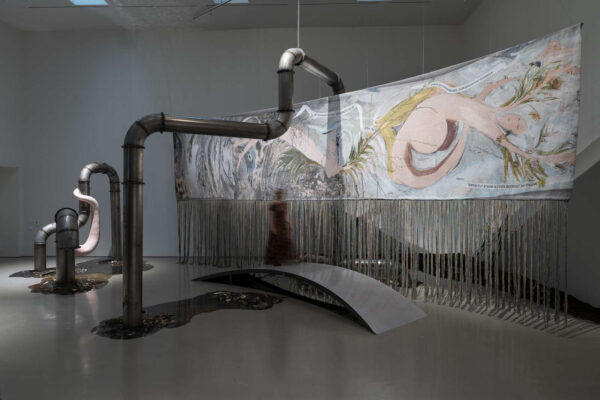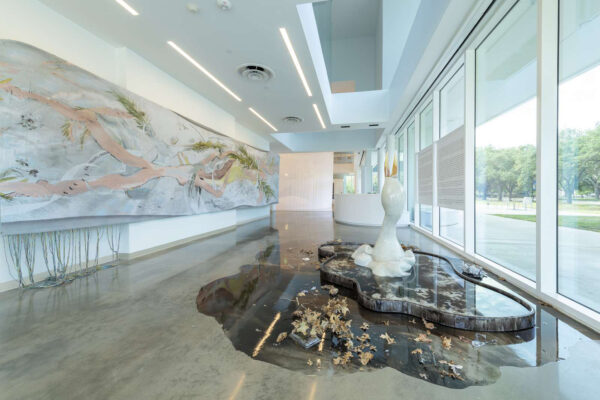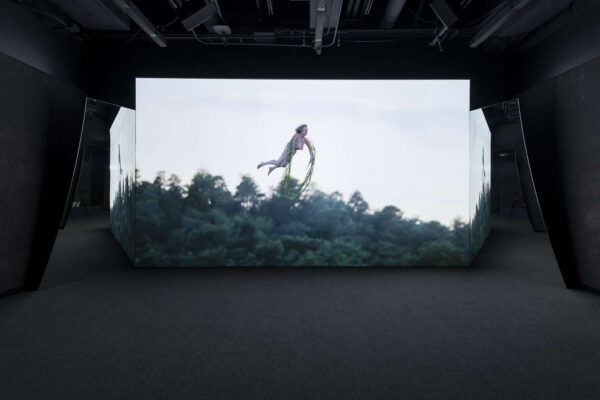
“Laure Prouvost: Above Front Tears Nest in South,” installation view at the Moody Center for the Arts. Photo: Anthony Rathbun
You know those dreams you have that you wouldn’t share with your shrink, lest she tease out some down-to-earth, materialistic meaning from them? This is how I remember my first Laure Prouvost experience, back in 2011, at the private art center Collezione Maramotti in Italy’s Reggio Emilia. I don’t even want to google it, as the image is crystal clear in my mind: as part of a larger work, there were several bicycle rearview mirrors, positioned horizontally and attached to poles, with fresh raspberries on top. They were free for the taking; to pop berries in an exhibition outside the context of catering felt a little bit like flying: you’re not supposed to switch on your tastebuds, but here you did. More importantly, this part of the installation connected the viewer to Prouvost’s main narrative method, that of foraging. In many of her films and installations, the artist constructs a fictional ahistoric world where there are no hunters (and, consequently, almost no men), only gatherers. It feels as if we train our sense of touch and taste when we are in Prouvost’s exhibitions, for they are extremely haptic even when no consumable objects are on view.

“Laure Prouvost: Above Front Tears Nest in South,” installation view at the Moody Center for the Arts. Photo: Anthony Rathbun
Prouvost was celebrated on that predictably sunny day on the outskirts of the anarchist capital of Italy for winning a prestigious art award the Max Mara company gives out to women artists. Bigger milestones soon were hit, and she received the 2013 Turner Prize and represented France at the 2019 Venice Biennial. Her expansive show at the Moody Center for the Arts is not a career milestone — Houston neither makes nor breaks artists — but it does not feel like a gas station stopgap either. Above Front Tears Nest In South is a technically ambitious effort. It is a song of freedom from COVID restrictions, an elegy to long-haul flights and familial hugs. It is also deeply silly, sly, hilarious, and consistently wonderful.
Over the years, Prouvost has foregrounded certain topics in her work. She is interested in a process she calls ‘delearning,’ an intuitive type of spatial orientation in the physical environments and the world of signs. She also works a lot with language and translation, and her recent work often includes purposeful mistakes in English syntax and grammar. All this sounds strictly conceptual, but in fact serves a specific purpose: Laure Prouvost wants to turn you, the viewer, into an octopus, a “representation of the foggy border between feeling and thinking,” as the press release of her latest show in New York puts it. You have to use your mind’s tentacles to really ‘know’ things and meanings in her work. You happen upon things, and you make them mean something, similar to a first walk through unknown terrain. Here, symbols, forms, and substances are not attributes of one another (as in, red light means stop), they are each other: symbols form substances, and forms substantiate symbols.

“Laure Prouvost: Above Front Tears Nest in South,” installation view at the Moody Center for the Arts. Photo: Anthony Rathbun
One fun consequence of thinking about art in terms of foraging and gathering is that the lines between media blur. Prouvost makes sculpture, tapestries, films, all stylistically separate but connected by a certain route, with turns and detours that unveil new things to discover, some throwaway, some elegant, like her fantastical glass animals that randomly pop out on your way. The exhibition starts with a tall fish head fountain, a nod to Baroque garden architecture, surrounded by trash, both imported from Europe and found on Houston streets. A long tapestry in pinks and pastels depicting abstracted female figures with branches for hands leads the audience further to the video room, where the protagonist of this exhibition is first seen. It is the artist’s grandmother, but she’s not the usual stand-in relative from another era to project today’s sentiments onto.
The artist knows that fiction often travels further than fact. In the era when everybody and their mother makes work about their grandmother, forming a neurotic attachment to personal histories that get slashed into mincemeat every time we’re online, Prouvost’s approach to the past is devoid of invitations to trauma bond over real and exaggerated injustices. Her grandma is pure, phantasmagoric fiction, bird mother of the Earth soaring through urban and natural vistas.

“Laure Prouvost: Above Front Tears Nest in South,” installation view at the Moody Center for the Arts. Photo: Anthony Rathbun
She reappears further into the show, in a tapestry yurt, where we discover that she wields other magic powers: grandma can, for example, turn a 5 euro bill into a 50 euro bill by hatching it (this sequence is hysterical). Outside the yurt we see an industrial landscape of trash, steel tubes, another tapestry, and a sensuous biomorphic sculpture. An absolute highlight of the show is a VR video in a woven basket that you have to pull over your head and feel delightfully stupid while doing so. This is part of the point: To ‘delearn,’ you have to shed some of the self-consciousness that helps you operate efficiently in public and the workplace. The video transports you to the exhibition’s previous location, Oslo, Norway, but it’s not a 3D-tour. Instead, in a split second you’d be startled by a fleet of naked women, of various ages and races, dancing around you and prattling a singspiel of almost absurd glossolalia in voices that are soothing and encouraging in equal measure.
After this experience you’ll hardly be the same. This video fulfills the promise of VR in the art context for the first time in my memory. It places the audience in close, immersive, but safe proximity to one work — the women’s interpretative dance — while explaining and populating the other, real-space, environment with spirits one can now imagine prancing along the Moody’s somber white walls. After this assault on the senses, you’re supposed to go back to the previous gallery and repose on a cloud (not a literal cloud, though I wouldn’t be surprised if Prouvost figures out the condensation furniture technology for her next show). Precarious constellations of colorful trash, halfway between a Calder mobile and a wind chime, float above you. Make a wish.

“Laure Prouvost: Above Front Tears Nest in South,” installation view at the Moody Center for the Arts. Photo: Anthony Rathbun
It takes a fleet of scholars, including Prouvost’s famous countryman Bruno Latour, to question and undermine the nature-culture divide, but the artist jumps over it effortlessly. And, adding to that, she holds our hand while making this leap, guided by the screenwriting principle of ‘show, don’t tell.’ Or, better yet, ‘state, don’t preach’: While it would be easy to label her work ‘eco-conscious,’ she’s not raising awareness through infographics or emotionally manipulative disaster porn. Her goal is to change the mechanics of your mind. After the show, you’re invited to carefully step through life as if you were a gatherer, paying attention to the colors, the sounds, the organic and the toxic, working through the whole ecology of your material, sound, and color surroundings, not just the dramatic parts.
Laure Prouvost: Above Front Tears Nest in South is on view at the Moody Center for the Arts at Rice University in Houston through December 14.


